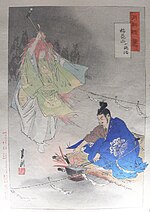An Inari shrine (稲荷神社, Inari jinja) is a type of Japanese shrine used to worship the kami Inari. Inari is a popular deity associated with foxes, rice...
13 KB (1,612 words) - 08:34, 20 December 2024
Takekoma Inari Shrine (竹駒稲荷神社) is a Shintō shrine in the city of Iwanuma in Miyagi Prefecture, Japan. It is considered one of the three main shrines dedicated...
5 KB (493 words) - 20:36, 12 November 2023
with Inari at Fushimi Inari are Ukanomitama, Sarutahiko, Omiyanome, Tanaka, and Shi. However, at Takekoma Inari, the second-oldest Inari shrine in Japan...
30 KB (4,858 words) - 22:24, 24 November 2024
Shrine Shirahige Shrine Sumiyoshi Shrine [ja] Takekoma Inari Shrine Tsubonuma Hachiman Shrine Zuihōden Koshiō Shrine Kumano Shrine Sanko Shrine Tsuchizaki Shinmeisha [ja]...
25 KB (1,743 words) - 16:37, 6 September 2024
present-day Iwanuma was part of ancient Mutsu Province, and the Takekoma Inari Shrine claims to have been founded in 842 AD. Mention of “Iwanuma Castle”...
10 KB (554 words) - 23:11, 3 October 2024
classified Shinto shrines as either official government shrines or "other" shrines. The official shrines were divided into Imperial shrines (kampeisha), which...
73 KB (1,690 words) - 12:43, 14 September 2024
A Beppyō shrine (Beppyō Jinja (別表神社)) is a category of Shinto shrine, as defined by the Association of Shinto Shrines. They are considered to be remarkable...
57 KB (705 words) - 20:22, 27 December 2024
Kanjō (section Inari kanjō)
would become Takekoma Inari. In 1194, Emperor Go-Toba decided that only Fushimi Inari Shrine could perform any of the parts of the Inari kanjō, however...
6 KB (670 words) - 10:35, 18 December 2023





